Introduction
Gastrointestinal disease causing signs of abdominal pain in horses is commonly referred to as colic. Colic is the most important and fatal disease of horses and considered as an important cause of death (Radostits et al., 2007). This case study is based on two consecutive episodes reported in a Thoroughbred mare named “Chestina” at Sashastra Seema Bal (SSB) Academy, Bhopal (MP). First incidence was diagnosed as obstruction (impaction) without strangulation in large colon, which was treated successfully for 06 days and animal recovered.
Second episode of colic occurred in the same animal at an interval of about 30 days which was so severe that the animal collapsed on the same day in spite of all possible efforts. After this incident management practices were reviewed to prevent such incidences of colic in horses, as to a larger extent it is preventable by improving management practices and informing riders/ paravets/ officials who look after horses about the problem. It is important to mention that by implementation of reviewed management practices, incidence and severity of colic has been reduced drastically. Preventive strategies based on scientific logic are described in this write up.
Prevention Strategies
After the sad demise of mare Chestina, management aspects/practices were reviewed in the light of scientific logic and following amendments were adopted.
1. Sensitization of Staff/Riders/Paravets: Horses in the unit are looked after by rider(s) starting from morning first parade to day off in the evening. During the whole day riders interact with horses through various activities viz. prepare horses for riding, exercise, watering, feeding, grooming and accompanying during grazing. From the earlier incidences it had learned that awareness for identifying early warning signs such as less water intake, hard faecal balls, less faecal output, presence of undigested grains, smell or worms in faeces helps in identifying susceptible animal(s). Further, susceptible animal is attended with adequate remedial measures to avoid the severe clinical presentation of colic.
2. Feeding and Watering: A unique GI anatomical and various physiological/behavioural factors predispose horses for colic (Hillyer et al., 2001). In contrast to dairy animals, horses are the creatures that can’t be stabled for long without providing exercise. In feral conditions, horses graze 18 hrs a day and cover miles of distance while grazing (Blikslager and Antony, 2008). This provides optimal condition for functioning of their digestive system. So in compliance of behavioural requirement:
i) Horses at academy are allowed to graze in the open grassland after morning exercise and watering parade.
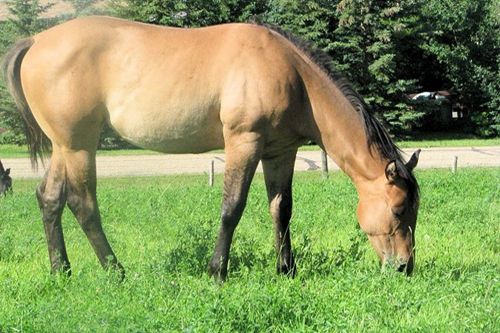
ii) Horses that have access to pasture or dry lot without constant access to water have a significantly increased risk of colic (Reeves al., 1996). In the stable, horses are offered ad-lib clean and fresh water and soaked hay (dip hay in water and allowed to dry in hay net). Soaking of hay removes dust and turns it more palatable.
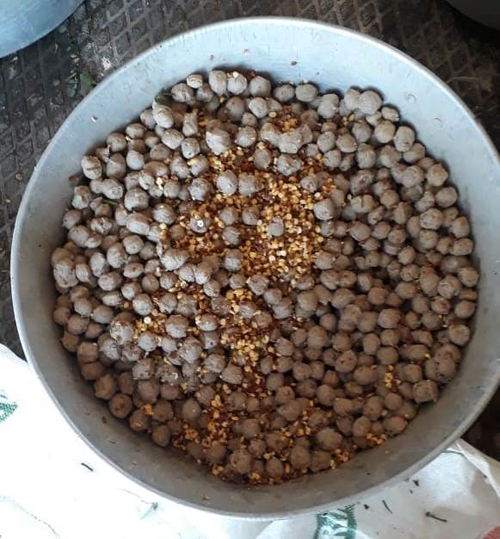
iii) Sudden changes in the diet, both concentrate and hay is related to increased risk of colic (Cohen et al., 1996). Hence changes should be done in gradual manner (atleast in a period of 2 weeks). Following practices/changes were made at academy related to feeding of concentrate ration.
- Total quantity of feed offered in a day was cut short by 1/3rd and remaining 2/3rd portion offered in 3 meals a day at regular intervals instead of 4 meals.
- Rolled oats introduced in grain menu, it was introduced gradually (250 gm/day to 1.5 kg per day in period of 5-6 wk), at the same time quantities of gram and barley reduced.
- Grain concentrate contain large amount of starch which is digested by enzymes in the small intestine to form simple sugars for absorption in the intestinal mucosa. Here it is pertinent to mention that, oat grain is better than corn as, 84 % of starch derived from oats is digested in the small intestine as compared with 29% of corn (Meyer, 1993). Any starch that escapes digestion in small intestine is converted to lactic acid in the large intestine by microbial digestion. This lowers the intestinal PH to the level which can damage intestinal mucosa and change microbial flora leading to colic (Argenzio, 1975).
iv) Grain ration (rolled oat, crushed gram, Soya meal, barley with wheat bran and corn oil) is provided to horses in three meals, i.e. morning, mid day and evening in increasing amount. It is to be ensured that grain ration to be soaked in water at least 4 hrs before feeding and all animals must be watered half an hour before feeding. In winters cooked rolled oats and barley are provided to the horses for better digestion. All concentrate meal are mixed properly with corn oil @ 50 ml/horse and distributed as per individual basis and need. Moreover, it has to be kept in mind that ration amount is given as per individual need basis and in no case concentrate ration should be more than 2 kg for adult animal of BW 500 kg (Sarah, 2005).
v) On the day before the Sunday or when the next day is scheduled holiday, last meal of the day is mixed with colic mixture (Magnesium sulphate, Soda-Bi-Carb and Salt in 3:1:1 ratio @ 50 gm/horse), Himalayan battisa, Ajvain and asafoetida. Further, on holidays animals are offered only single concentrate meal during evening and rest of the day they thrive on hay and grazing.
vi) All animals are provided 3 consecutive doses of Psylium husk @ 200 gms/animal mixed in evening meal on every fortnightly basis. It helps to prevent enterolith formation, as horses are close grazer.
vii) It is very important to identify the feed intake behavior of animal, some animals gulp their food without proper mastication, this leads to gulping of air, that can be best avoided by spread of ration or mixing it with hay/grass/carrots for proper mastication. Similarly, feeding on the individual basis is utmost requirement depending upon the age, breed, sex, physiological status, climate and work performed.
viii) In rainy season ration of animals is cut to halves and grazing hours are increased. It has been noticed that this practice doesn’t affect the body condition score of animal, moreover inadequate exercise induced colic incidences are reduced in this season.
3. Intestinal worms and deworming: Gastrointestinal parasites contribute to GI disturbances, including impactions, motility disorders, diarrhoea and peritonitis by the damage they cause to the intestinal vasculature and mucosa (Joseph, 2005). Large strongyles are regarded as the most pathogenic equine internal parasite, with S. vulgaris being regarded as the most injurious. Ingested S. vulgaris larvae (L3) migrated from gut through the intestinal arteries to the cranial mesenteric artery; mature larvae then return via the arterial tree to the large intestine. The prepatent period ranges from 6-12 months for the large strongyles (strongylus spp, Triodontophorus spp) and 6-12 wks for small strongyles (Trichonema/Cythostomum spp) (Higgins and Wright, 1999). S. vulgaris exerts its injurious effects by causing extensive damage to the endothelium of blood vessels inducing thrombosis along its course of migration.
In order to avoid parasitic associated colic and other GI problems, regular and comprehensive deworming of all horses is being followed strictly. Under this following principles are implemented.
i) All animals are treated with broad spectrum anthelmintic every 3 months and in rainy season at an interval of 2 months.
ii) In order to avoid drug resistance, chemically unrelated compounds are used at academy in a sequential manner: liquid Ivermectin solution – liq. Pyrantal Pamoate- Fenbendazole – Ivermectin+ pyrantal pamoate oral paste.
iii) Deworming through stomach tube is the best way for liquid dewormers, followed by oral paste and bolus preparation. Dose of dewormers must be based on exact body weight and must be slightly higher to compensate the loss during dispensing of drug.
iv) Drug efficacies are monitored by examining faecal egg reduction via quantitative faecal sample examination after 14 days of deworming.
v) If any horse shows apparent signs of worm infestation eg. sudden onset of diarrhoea, bad odour in faeces, weight loss etc., an additional deworming is done apart from regular schedule.
vi) Coprophagy by horses should be discouraged either by instant removal of manure, or sprinkle ash over the pile of manure. Riders and other officials must be aware on this issue.
vii) In order to break parasitic life cycle animals are rotated in earmarked areas for grazing at 7-10 days interval. All grazing plots are grazed with another species for the same said purpose.
4. Increase Turnout: In order to promote natural behaviour of continuous grazing and walking, it is ensured to maintain horses outside the stables for sufficient time. Outside turnout prevents boredom-related abnormal behavior (eg. cribbing and weaving) and reduces the risk of large- intestinal impactions. Grazing also helps to reduce the incidence of gastric ulcers (Wendy, 2005). It is recommended that a horse should receive ideally 18 hours of grazing time each day (Blikslager and Antony, 2008) as in the wild condition. However, following precautions are to be followed while turnout of animals.
i) Animals should not be allowed to graze misty grasses, as it may stimulate intestinal spasm (spasmodic colic). Therefore, in winters animals should not be moved out in very early in the morning. However, grazing of rain bathed grasses doesn’t cause any harm.
ii) In summers, animals are moved out early in the morning and late in evening.
iii) Horses should not be allowed to graze in sandy areas, near ponds or stagnant water bodies.
5. Dental care: Most of the large animals are anisognathic i.e. intermandibular space is narrower than intermaxillary space. In horses, this together with limited natural movement of mandible, results in the development of enamel points (dental hooks) on the buccal edges of upper arcades and on the lingual edges of the lower arcades (Gordon, 2005). To avoid painful tooth or sore mouth condition, horse is unable to masticate well, allowing long undigested fibers passing down and causing colic (Toit, 2009). Dental problems are risk factors for horses, especially recurrent and obstructive type of colic (Hillyer et al., 2002; Scantlebury et al; 2011). Regular dental examination and rasping is required to avoid such problems. Enamel points are best treated by dental rasping/floating; this is to be done twice annually. Manual as well as electric raspers are available and can easily be used with help of Hausmann mouth gag.
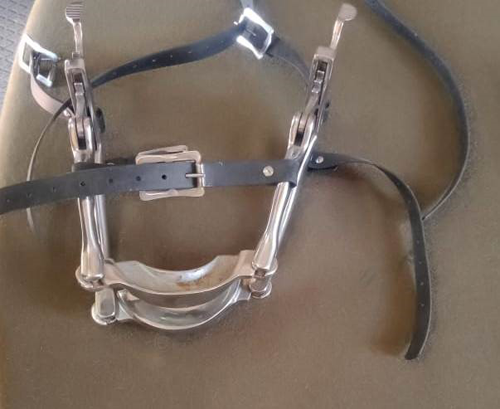
6. Exercise: Due to long length of intestine horses need regular exercise for good gut health. Improper and inadequate exercise such as recent change of stabling and exercise schedule reduces large intestine peristalsis, resulting in simple obstruction and distension of colon making animal prone for colic (Hillyer et al., 2002). Moreover, exposure to cold, fatigue, exhaustion, wet stormy weather and overwork; paralyze the digestive system, making equines more susceptible to colic (Mott, 2004; Scantlebury et al., 2011). Sometimes due to bad weather conditions, routine riding exercise is not executed, thus it is advised to provide lungeoning to animals on both reins without harness.
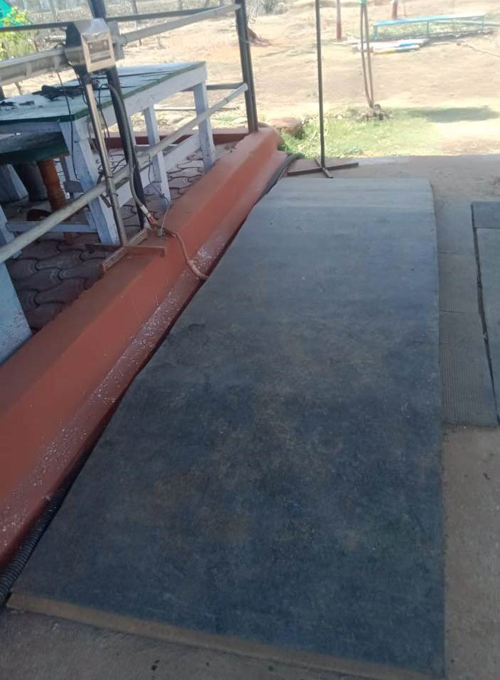
7. Regular assessment: Regular assessment gives an overview of working with animals and in case something found in disarray, proper remedial measures may be initiated promptly. Regular health examination, on the basis of body weight, vital clinical parameters and dental examination helps to understand individual as well as herd health. In the examination immediate environment of animal is also monitored that includes cleaning of manure, manger and water trough, condition of harness/blanket and grooming items. Blood, faecal and urine samples of animals are also examined on quarterly basis. There are some early warning signs of poor gut health i.e. poor coat condition, sensitive flanks, compensatory lameness, undigested grain in manure, intermittent or mild diarrhea and difficulty in maintaining weight. During regular assessment veterinarian is to look for such signs and take timely corrective measures.
8. Record of incidences: Documentation of disease incidences is very important to identify susceptible animal(s) and it also helps to trace route cause in organized setup. Case details in cases of animals that fail to recover must be studied to identify the pattern of incidence i.e. season, age, breed, sex and adjunct history viz. travel, stall rest, accidental feeding, excessive work and change of feed/hay. Study of such documents help to plan location based strategies which could improve management practice and animal welfare.
Conclusion
“An ounce of prevention is worth then a pound of cure” Since, Colic in equines is caused by several causes thus its incidence isn’t fully preventable. However, by working on management practices its incidence and severity has reduced significantly. Besides, it has helped in cutting down the expenses on treatment and has improved the herd welfare in all respect.
References
- Argenzio, R. A. (1975). Function of the equine large intestine and their interrelationships in disease. Cornel Veterinary, 65: 303.
- Blikslager, K. and Anthony, B. (2008). “Avoiding colic through management.” 47-54.
- Cohen, N. B., Matejka, P. L. and Honnas, C. M. (1996). Case control study of the association between various management factors and development of colic in horses, Journal of American Veterinary Medicine Association, 206: 667-73.
- Gordon, J. B. (2005). The Merck Veterinary Manual, 9th Edition, Merck & Co. Inc, Whitehouse Station, NJ, USA, Pp. 142.
- Higgins, A. J. and Wright, I. M. (1999). The Equine manual, 1st edition, W. B. Saunders, Pp. 90.
- Hillyer, M. H., Taylor, F. G. and French, N. P. (2001). A cross-sectional study of colic in horses on thoroughbred training premises in the British Isles in 1997, Equine Veterinary Journal, 33(4): 380-385.
- Hillyer, M. H., Proudman, C. J., Edwards, G. B., Smith, J. E. and French, N. P. (2002). Case control study to identify colic in horses, Equine Veterinary Journal, 34 (5): 455.
- Joseph, A. D. (2005). The Merck Veterinary Manual, 9th Edition, Merck & Co. Inc, Whitehouse Station, NJ, USA, Pp. 1738.
- Meyer, H. (1993). Investigation on pre-ileal digestion of oats, corn and barley starch in relation to grain processing, Proceedings 13th Equine Nutrition and Physiology Symposium.
- Mott, L. (2004). Diseases and parasites of horses and mules. 2nd edition, Delhi, India, Pp. 188.
- Radostits, O. M., Gay, C. C., Blood, D. C. and Hinchcliff, K. W. (2007). Veterinary Medicine: A Text Book of the Diseases of Cattle,Sheep, Pigs,Goats, and Horses. 10th edition, W.B. Saunders Company, Pp. 215.
- Reeves, M. J., Curtis, C. R. and Salman, M. D. (1996). Risk factors for equine acute abdominal disease (colic). Results from multicentric case control study, Preventive Veterinary Medicine, 26: 285-301.
- Sarah, L. R. (2005). The Merck Veterinary Manual, 9th Edition, Merck & Co. Inc, Whitehouse Station, NJ, USA, Pp. 1880.
- Scantlebury, C. E., Archer, D. C., Proudman, C. J. and Pinchbeck, G. L. (2011). Recurrent colic in the horse: incidence and risk factors for recurrence in the general practice population. Equine Veterinary Journal, 43(39): 81-88.
- Toit, N. D. (2009). Clinical dental examination of 357 donkeys in the UK. Part: Epidemiological studies on the potential relationships between different dental disorders, and between dental disease and systemic disorders. Equine Veterinary Journal, 41(4): 395-400.
- Wendy, E. V. (2005). The Merck Veterinary Manual, 9th Edition, Merck & Co. Inc, Whitehouse Station, NJ, USA, Pp. 1736.
|
The content of the articles are accurate and true to the best of the author’s knowledge. It is not meant to substitute for diagnosis, prognosis, treatment, prescription, or formal and individualized advice from a veterinary medical professional. Animals exhibiting signs and symptoms of distress should be seen by a veterinarian immediately. |



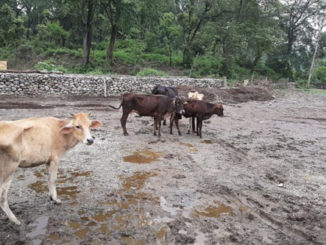
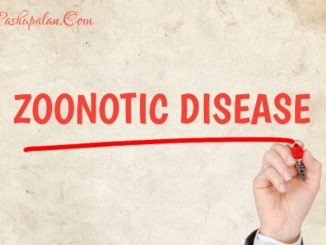
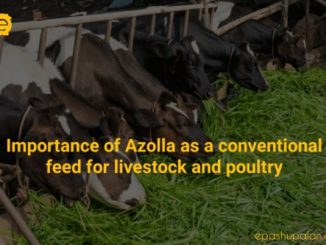

Excellent review
Excellent write up
Colic in equines is a major problem. These prevention strategies will be helpful for equine lovers.
Very good snr ji
Very well explained in a practical way.
Excellent write up! Very useful for equine lovers!
Good management practice
Excellent review on colic.
Excellent review of colic in equines which gives a good insight about colic prevention. Great review.